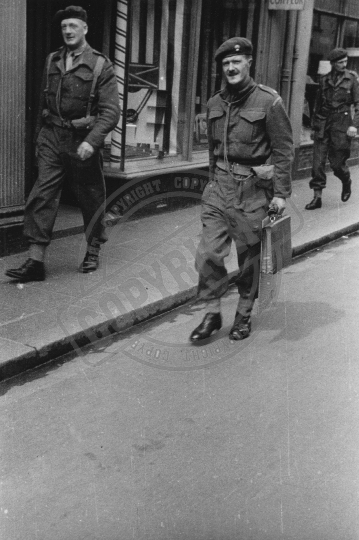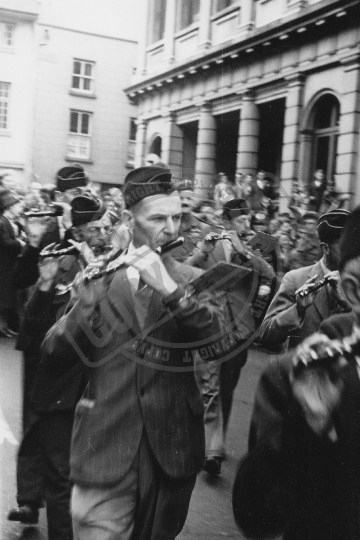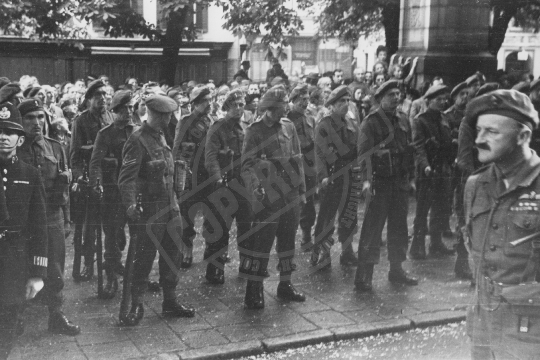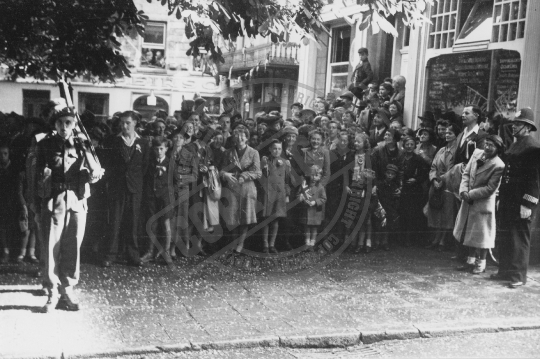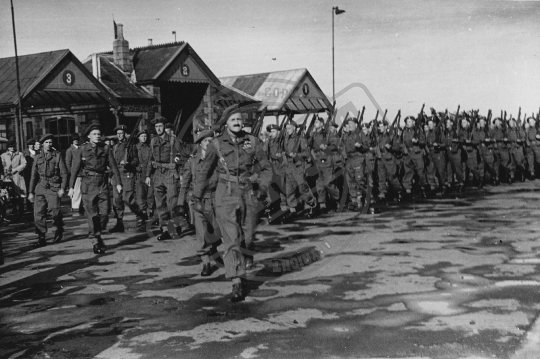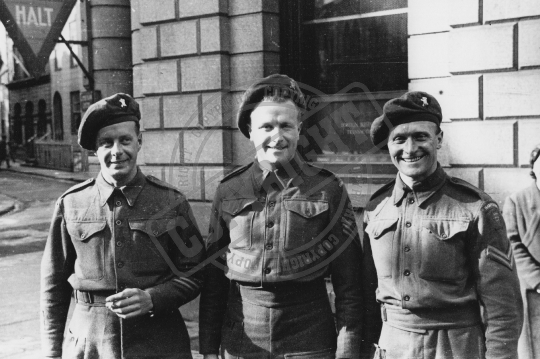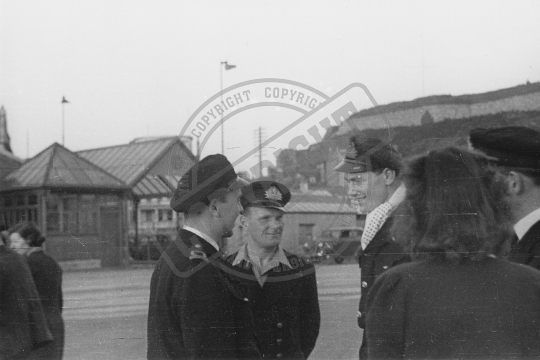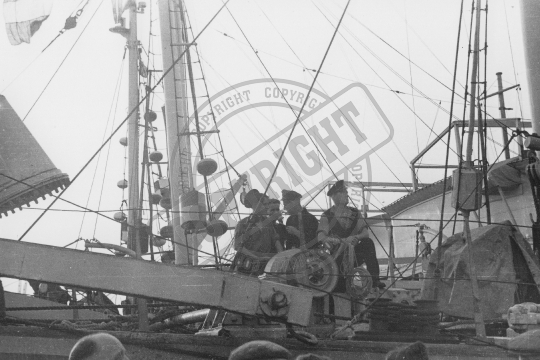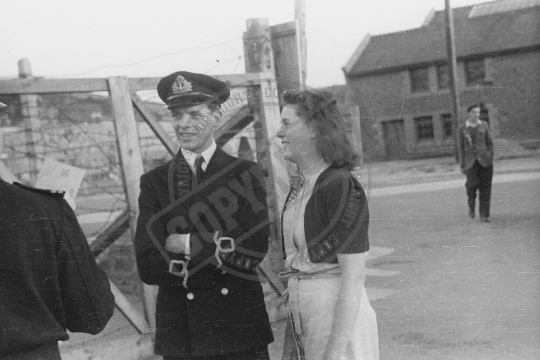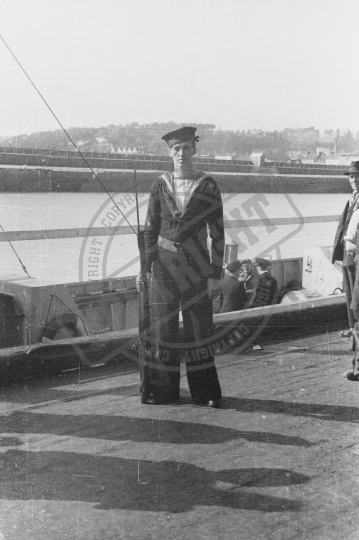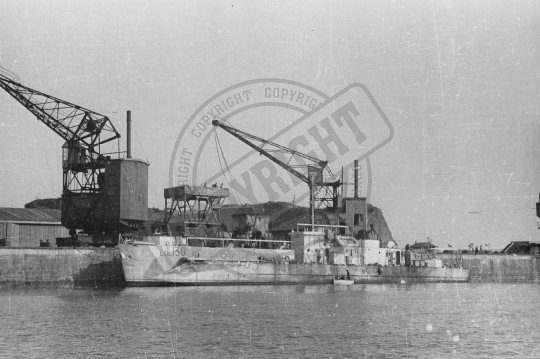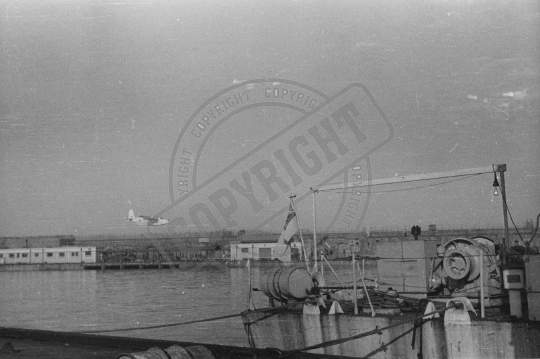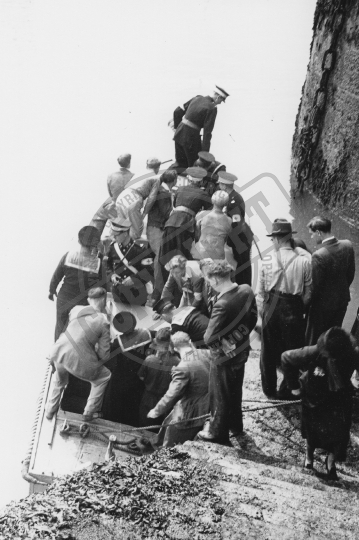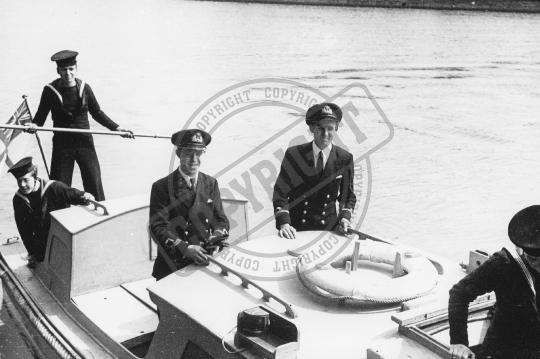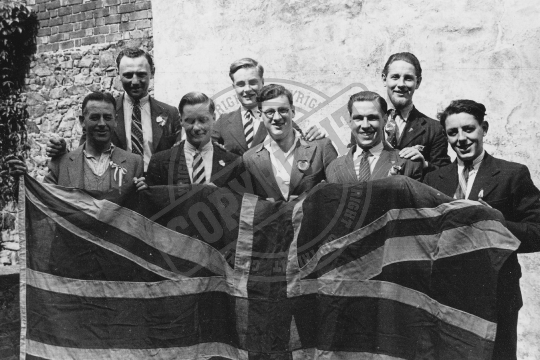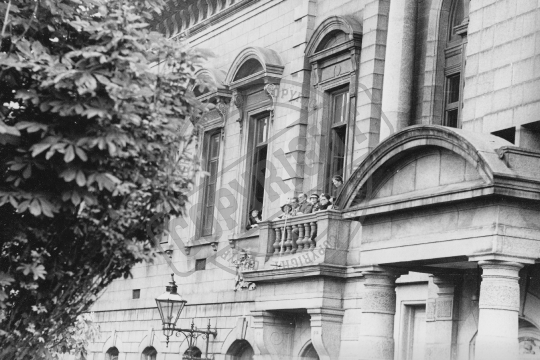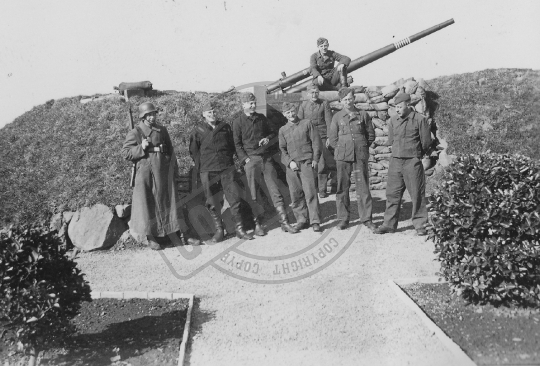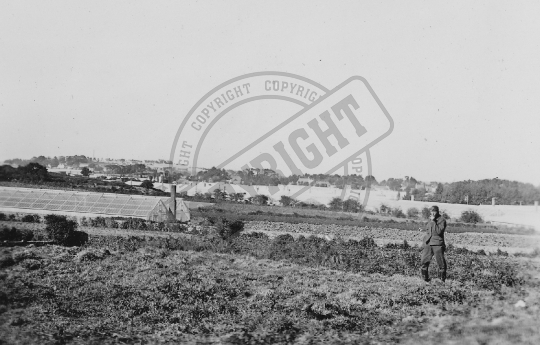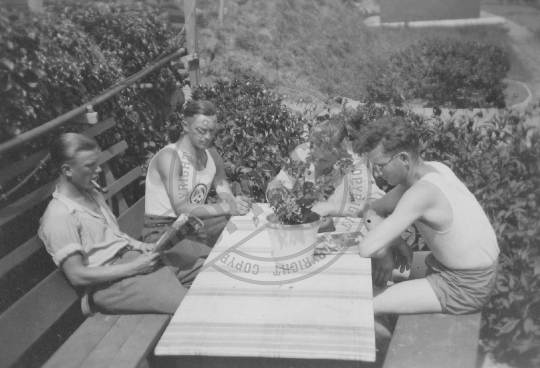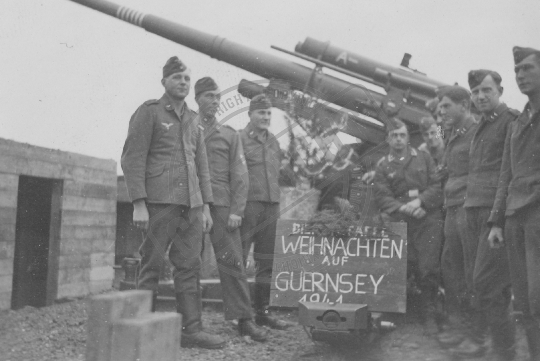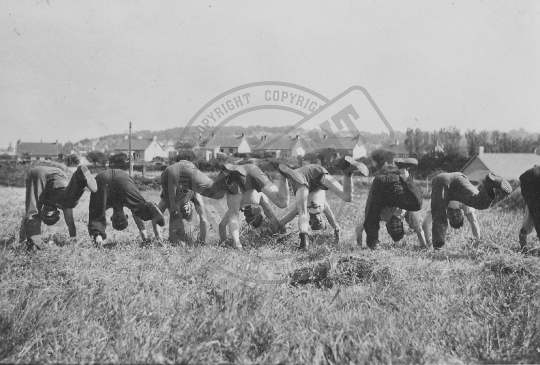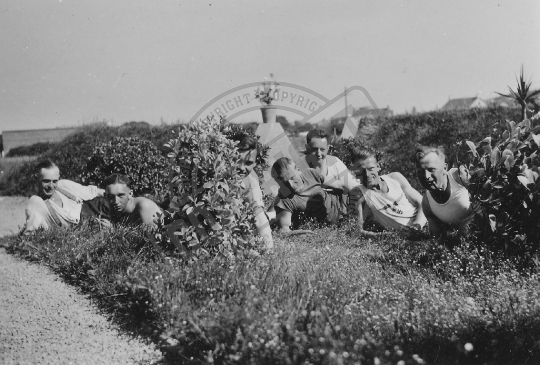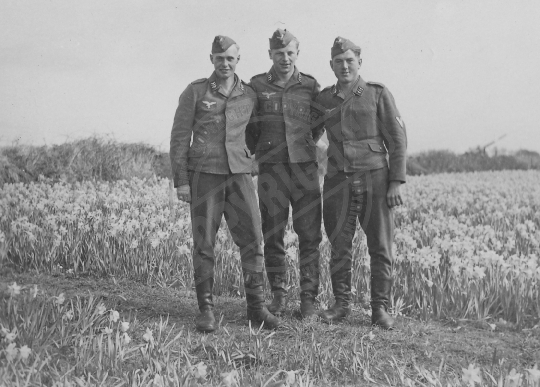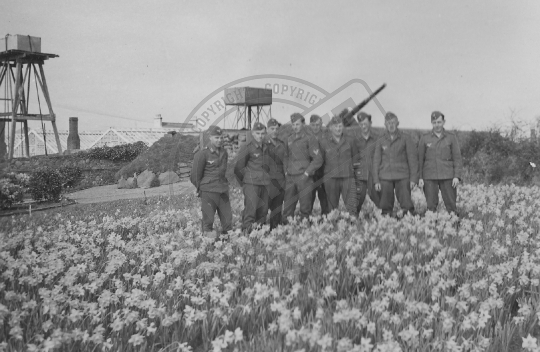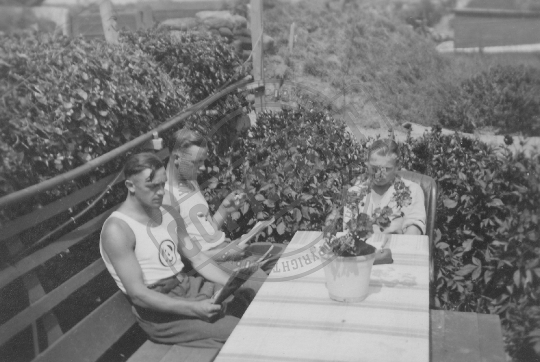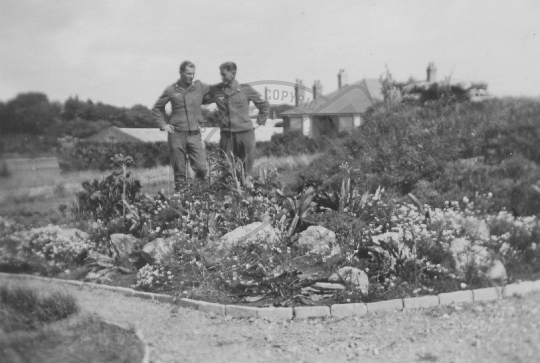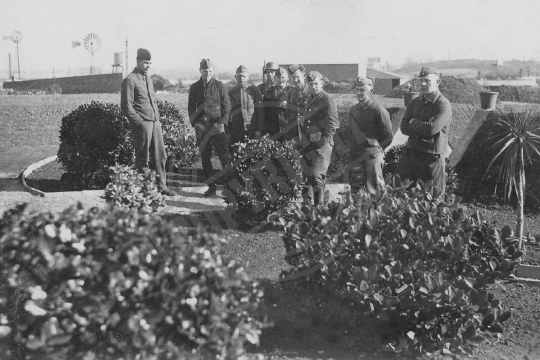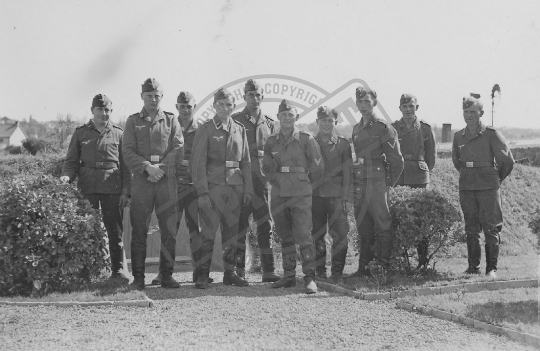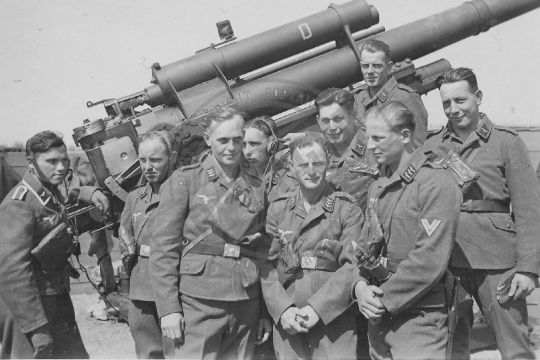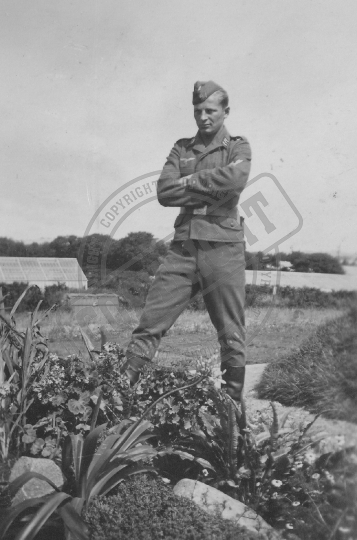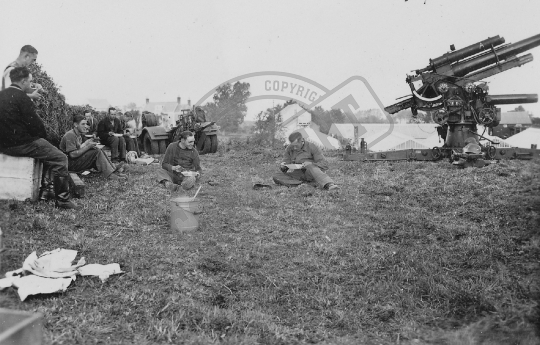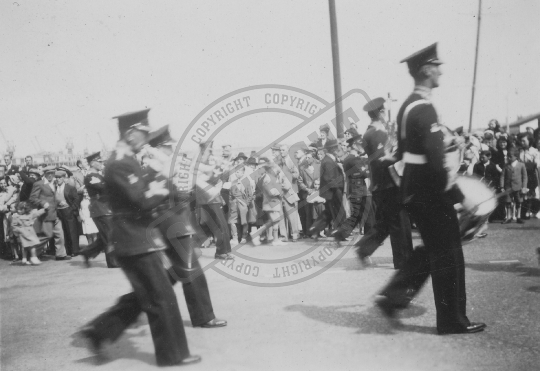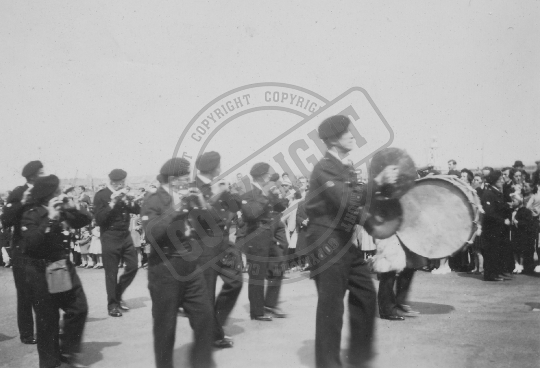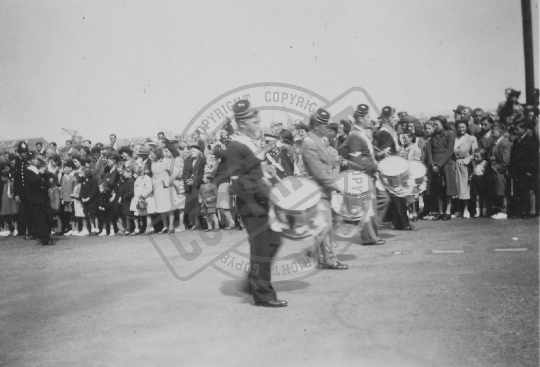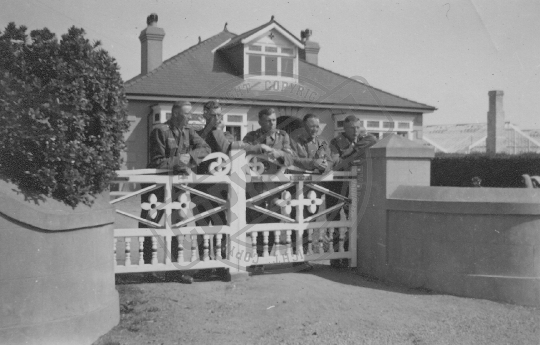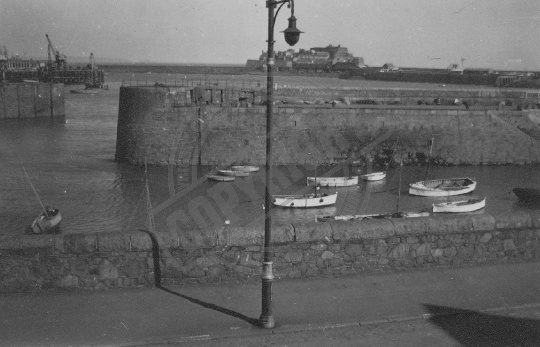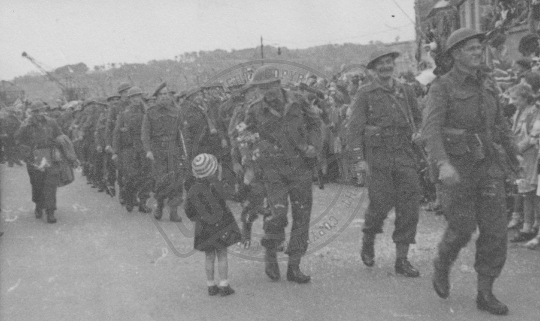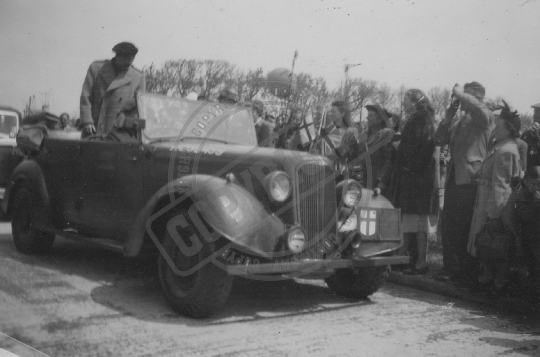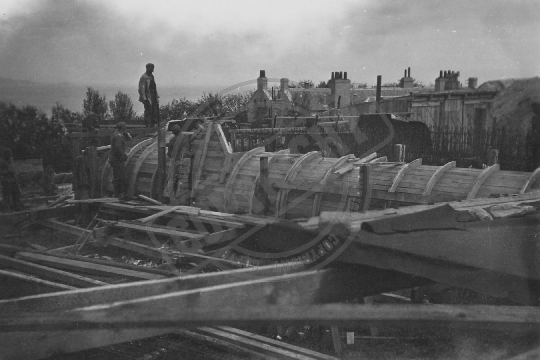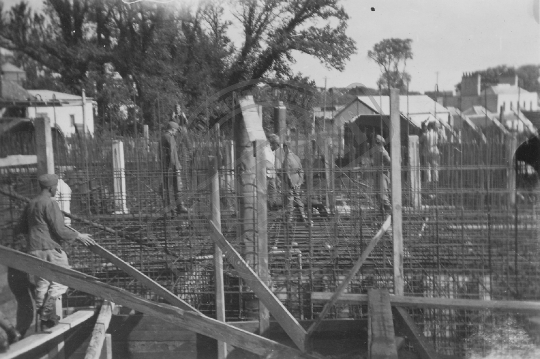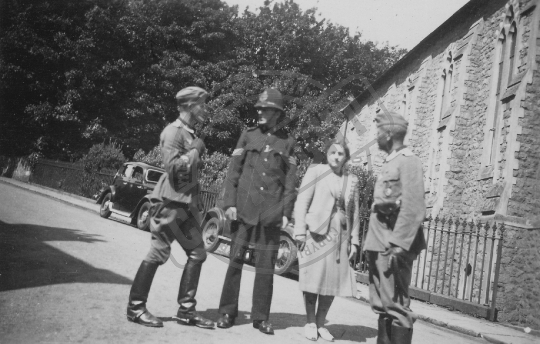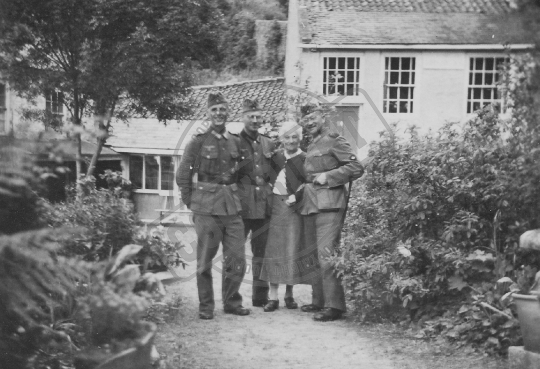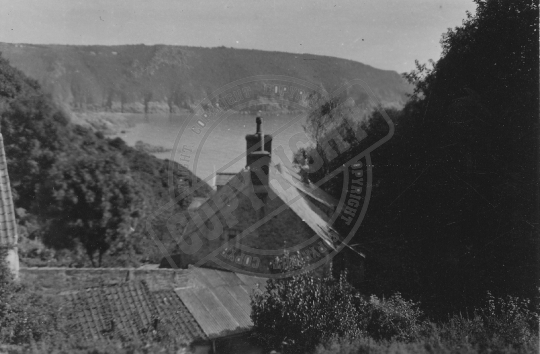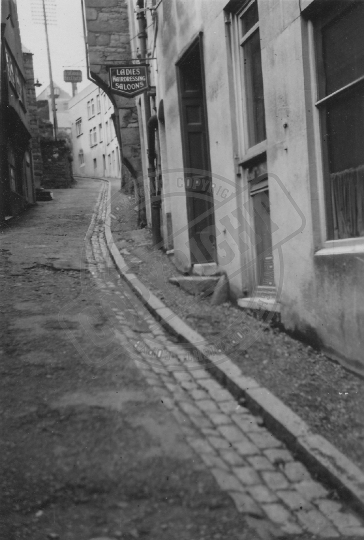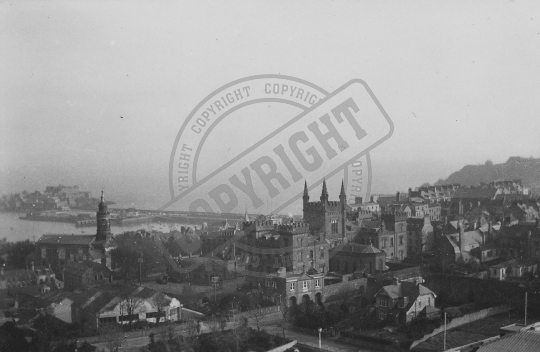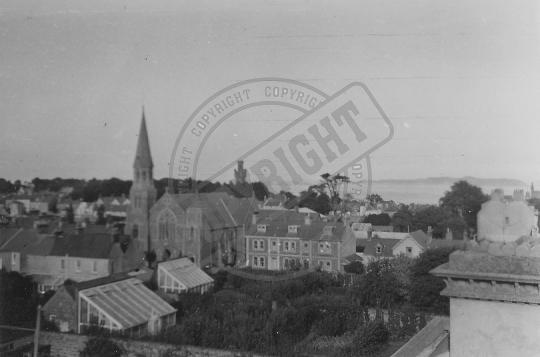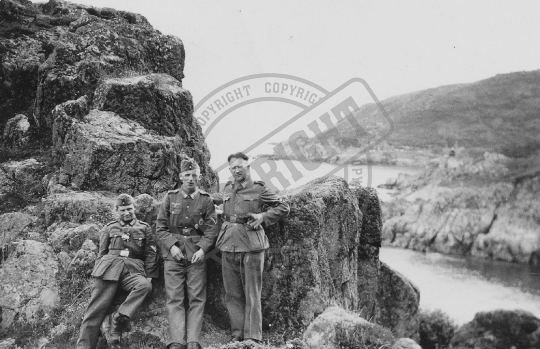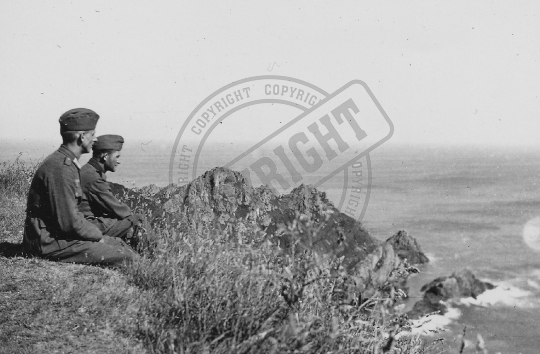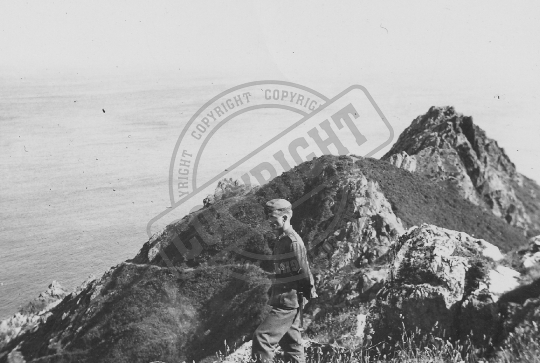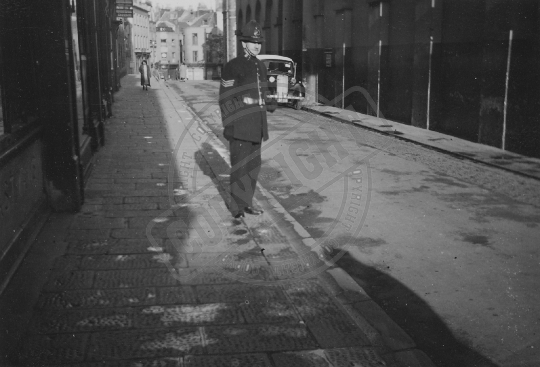Results (369)
CIMM_0071
Jersey Friday 11th May 1945. The Royal Court’s first sitting since the Liberation of Jersey assembled at 11 a.m. on Friday morning, 12 May 1945. In attendance were Force 135 officers including L to R; Captain C. Hargreaves, Major Anderson, making their way through the streets of St Helier to the Court.
CIMM_0069
Jersey Thursday 10th May 1945. After the speeches the St James Boys Brigade Band, headed by Dae Donavan their drum-major, struck up a rousing march and marched out of the Royal Square followed by Lt-Col Robinson and the troops that had formed the Guard of Honour.
CIMM_0068
Jersey Thursday 10th May 1945. The Guard of Honour and the Islanders wait patiently in the Royal Square for the States Members to arrive for the Hoisting the Flag Ceremony. Lt-Col. Robinson, deep in thought, paces the pavement outside the States Buildings.
CIMM_0067
Jersey Thursday 10th May 1945. The section of crowd at the Pierson Hotel end of the Royal Square wait eagerly for the ceremony to begin.
CIMM_0066
Jersey Thursday 10th May 1945. The Guard of Honour is marched off the Weighbridge led by Lt-Col Robinson and followed closely by Captain Le Brocq.
CIMM_0062
Jersey Thursday 10th May 1945. Three Jersey lads, Private Raymond Ahier, Sergeant Winter de Gruchy, and Corporal Alex Mangan, serving with the 11th (RMIJ) Battalion, the Hampshire Regiment, in Broad Street, Jersey.
CIMM_0059
Jersey Liberation Wednesday 9th May 1945. Royal Navy officers from the LCI(L) 130 and minesweepers exchange details at the top of the New North Quay, St Helier Harbour, whilst a Jersey girl listens eagerly to their conversation.
CIMM_0058
Jersey Liberation Wednesday 9th May 1945. Once moored alongside the New North Quay crew members of one of the HM Motor minesweepers relax after clearing the approaches to St Helier Harbour. This minesweeper is most probably the FY PT 542 commanded by Lieutenant Idris Edwards, RNVR.
CIMM_0056
Jersey Liberation Wednesday 9th May 1945. Local girls were eager to speak to the crew of the recently arrived Royal Navy vessels, as Sub-Lt Jimmy Cooper from the LCI(L) 130 soon found out.
CIMM_0055
Jersey Liberation Wednesday 9th May 1945. One of two sentries that were posted to guard the mooring ropes, maintain discipline and ensure security of the vessel to prevent over enthusiastic islanders boarding the LCI(L) 130 and removing items as souvenirs.
CIMM_0053
The LCI(L) 130 moored alongside the New North Quay, St. Helier Harbour, Jersey. Almost immediately the main 'Omelette’ advance party of some 200 men began to land at 5pm on Wednesday 9th May.
CIMM_0052
The RAAF Sunderland aircraft, which provided air cover for HMS Cosby and LCI(L) 130, flew at low level over the Albert Pier, Jersey to show the flag
CIMM_0048
The launch from HMS Beagle was swamped with autograph hunters at the end of the Albert Pier, Jersey.
CIMM_0045
A launch from HMS Beagle with two Royal Navy officers and four ratings on board prepares to tie up at the end of the Albert Pier, Jersey.
CIMM_0039
Jersey ex-political prisoners taken shortly after their release from the Newgate Street Prison. Left to Right: Bunny O’Neil, Mr. Rondel, Charles Gruchy, Martin Le Cornu, Hugh Le Cloche, Basil Thornton, the Dutchman Siebe Kosta, and John Bisson.
CIMM_0037
Tuesday 8th May 1945, the Jersey Bailiff, Alexander Coutanche, had a microphone erected on the balcony of the Royal Court witness room, facing the Royal Square. After the Prime Minister’s speech he spoke from the balcony to the crowd.
SP_0048.jpg
The gun crew of Flak Batterie Kapellendorf located off Les Grandes Capelles in St Sampson. This battery of four 8.8cm Flak 18 guns which were used in an anti-aircraft role. This sequence of photographs were taken in December 1941. Note the kill markings on the gun barrel.
SP_0046.jpg
Flak Batterie Kapellendorf located off Les Grandes Capelles in St Sampson. This battery of four 8.8cm Flak 18 guns which were used in an anti-aircraft role. This sequence of photographs were taken in December 1941.
SP_0044.jpg
The gun crew of Flak Batterie Kapellendorf located off Les Grandes Capelles in St Sampson. This battery of four 8.8cm Flak 18 guns which were used in an anti-aircraft role. This sequence of photographs were taken in December 1941. Note the Luftwaffe insignia on the PT shirts.
SP_0043.jpg
The gun crew of Flak Batterie Kapellendorf located off Les Grandes Capelles in St Sampson. This battery of four 8.8cm Flak 18 guns which were used in an anti-aircraft role. This sequence of photographs were taken at Christmas 1941.
SP_0042.jpg
The gun crew of Flak Batterie Kapellendorf located off Les Grandes Capelles in St Sampson. This battery of four 8.8cm Flak 18 guns which were used in an anti-aircraft role. This sequence of photographs were taken in December 1941.
SP_0041.jpg
The gun crew of Flak Batterie Kapellendorf located off Les Grandes Capelles in St Sampson. This battery of four 8.8cm Flak 18 guns which were used in an anti-aircraft role. This sequence of photographs were taken in December 1941.
SP_0040.jpg
The gun crew of Flak Batterie Kapellendorf located off Les Grandes Capelles in St Sampson. This battery of four 8.8cm Flak 18 guns which were used in an anti-aircraft role. This sequence of photographs were taken in December 1941.
SP_0039.jpg
The gun crew of Flak Batterie Kapellendorf located off Les Grandes Capelles in St Sampson. This battery of four 8.8cm Flak 18 guns which were used in an anti-aircraft role. This sequence of photographs were taken in December 1941.
SP_0038.jpg
The gun crew of Flak Batterie Kapellendorf located off Les Grandes Capelles in St Sampson. This battery of four 8.8cm Flak 18 guns which were used in an anti-aircraft role. This sequence of photographs were taken in December 1941. Note the Luftwaffe insignia on the PT shirts.
SP_0036.jpg
Flak Batterie Kapellendorf located off Les Grandes Capelles in St Sampson. This battery of four 8.8cm Flak 18 guns which were used in an anti-aircraft role. This sequence of photographs were taken in December 1941.
SP_0034.jpg
The gun crew of Flak Batterie Kapellendorf located off Les Grandes Capelles in St Sampson. This battery of four 8.8cm Flak 18 guns which were used in an anti-aircraft role. This sequence of photographs were taken in December 1941.
SP_0033.jpg
The gun crew of Flak Batterie Kapellendorf located off Les Grandes Capelles in St Sampson. This battery of four 8.8cm Flak 18 guns which were used in an anti-aircraft role. This sequence of photographs were taken in December 1941.
SP_0032.jpg
The gun crew of Flak Batterie Kapellendorf located off Les Grandes Capelles in St Sampson. This battery of four 8.8cm Flak 18 guns which were used in an anti-aircraft role. This sequence of photographs were taken in December 1941.
SP_0031.jpg
Flak Batterie Kapellendorf located off Les Grandes Capelles in St Sampson. This battery of four 8.8cm Flak 18 guns which were used in an anti-aircraft role. This sequence of photographs were taken in December 1941.
SP_0030.jpg
Flak Batterie Kapellendorf located off Les Grandes Capelles in St Sampson. This battery of four 8.8cm Flak 18 guns which were used in an anti-aircraft role. This sequence of photographs were taken in December 1941. Note the trailer for moving the gun in the background.
MT_0009
Big crowds gather on Liberation Day on May 9th 1946 to watch the procession in St Peter Port.
MT_0008
Big crowds gather on Liberation Day on May 9th 1946 to watch the procession in St Peter Port.
MT_0007
Big crowds gather on Liberation Day on May 9th 1946 to watch the procession in St Peter Port.
MT_0001
German army personnel relaxing outside a requisitioned property called The Croft in Les Canus, St Sampson formerly owned by Mrs Ruaux who was evacuated in 1940. This is a typical example of troops being billeted in local properties.
MT_0003
A view of the Careening Hard at half tide, note the bomb and shrapnel damage on the raised walkway just before the end of the pier resulting from the air raid on the evening of 28 June 1940.
MT_0002
Marching past the former White Heart Hotel sited opposite the Weighbridge, a young girl presents a pose of flowers to one of Guernsey’s Liberators on the occasion of the islands freedom on 9 May 1945.
MT_0006
Two years after Liberation on 23rd May 1947 Guernsey had a special visit from Field Marshall Bernard Montgomery (Monty). During his visit he met with many dignitaries including those from Elizabeth College, St John Ambulance, Sea Scouts and many others. His tour was welcomed by all with the streets of Guernsey lined with locals wanting to catch a glimpse of Monty. His famous vehicle known as Old Faithful carried him around the island and included a stop at the grounds of Beau Sejour.
OA_106
Shuttering and huge quantities of steel reinforcing surround construction workers as they prepare one of the many fortifications prior to concrete being poured in the grounds of Fort George.
OA_105
Shuttering and huge quantities of steel reinforcing surround construction workers as they prepare one of the many fortifications prior to concrete being poured in the grounds of Fort George.
OA_104
A local police sergeant and civilian photographed with German soldiers outside the old Police Station located opposite St Pauls Church. The church was subsequently demolished and is now the site of the Sunken Garden.
OA_103
German soldiers with a local resident at entrance to the former Moulin Huet Watermill, one of the properties alongside the road leading down to Moulin Huet Bay.
OA_101
Looking across the roof of the former Moulin Huet Watermill, sited alongside the road leading down to Moulin Huet Bay with Jerbourg headland and the beach of Petit Port at low water in the distance.
OA_100
A view from the foot of Bertholet Street looking up the steeply graded hill that emerges onto New Street.
OA_098
A view across the roof tops of St Peter Port from Victoria Tower, with the spire of St James seen left, the square towers of Elizabeth College on the right and Castle Cornet in the far distance.
OA_097
Taken from the roof of a house near the junction of Les Gravees and Queens Road looking towards the spire of St Jospephs Methodist Church and Victoria Tower in the far distance.
OA_095
Enjoying a stroll around Guernsey’s southern cliffs a group of Germans stop for a rest near Moulin Huet by Dog and Lion Rocks with the small harbour at Saints Bay seen in the background.
OA_094
Two German soldiers stop to enjoy the views on the cliifs just west of Pointe De La Moye which can be seen in the background.
OA_093
A German soldier stands on the coastal footpath leading to Pointe De La Moye looking east towards Les Sommeilleuses.
OA_090
A local police sergeant photographed by a German soldier in Market Street looking towards the steps that led to the Commercial Arcade.



